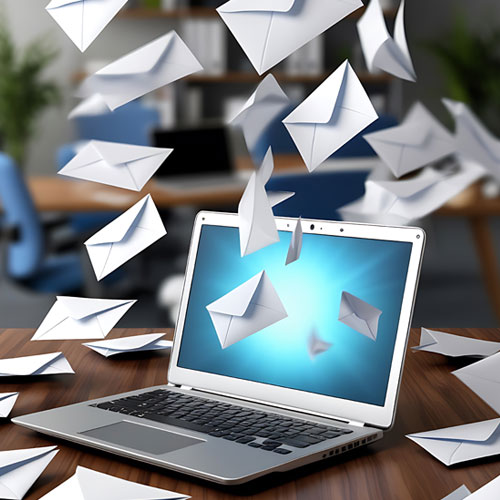Have you heard the term – Email Blast and wondered what exactly is it? Well, as the name suggests, Email blast refers to the blast or bulk email sent to a huge list of receivers who are already subscribed to your newsletters.
In today’s digital age, email marketing remains one of the most effective tools for businesses to reach their target audience and drive engagement. One popular tactic within email marketing is the email blast, where a single email is sent out to a large group of recipients simultaneously. While some may view email blasts as a mass communication strategy, when done correctly, they can be a valuable way to connect with your audience and drive results.
What is an Email Blast – Email Blast Meaning
In simple words, email blast refers to sending a single email to a very large group of audiences. The people in the list have already provided consent to receive your email, so the chances of email bounce or spam reports are negligible.
These subscribers already know you or your products or services and have given their consent to be included in your email list. These are your loyal customers or followers who love to consume your content or are interested in buying or subscribing to your products or services. Email blasts are usually done with a large list of subscribers, which can range from anywhere between 1000 to 100,0000 email contacts.
Sending emails to this many people at once is dangerous in general. However, with Email Blast, it is much safer because the subscribers already trust you and do not consider your email as spam. In fact, in most of the cases, they are eagerly waiting for your email to arrive in their inbox because they expect some new content to consume, get a new promotional offer, discount code, affiliate links to their favorite products, and much more.
This video explains the email blast meaning in detail:
Before diving into how to do an email blast, let’s briefly cover some key concepts related to email marketing. Email marketing is the practice of sending commercial messages to a group of people via email. This can include newsletters, promotional offers, product updates, and more. Email marketing can be a highly effective channel for businesses, boasting an impressive return on investment (ROI) when done right.
1. List Building for Email Blast
One crucial component of successful email marketing is building and maintaining a quality email list. This involves collecting email addresses from interested prospects and customers and ensuring that they have opted in to receive communications from your business. There are various ways to grow your email list, including offering valuable content, hosting webinars, and running promotions.
2. Segment Your Email List According to Audience Type and Categories
Once you have a robust email list in place, it’s essential to segment your audience based on factors such as demographics, interests, and buying behavior. This allows you to send targeted emails that are personalized and relevant to each recipient, increasing the likelihood of engagement and conversion. Modern email marketing platforms offer tools to easily segment your email list and create personalized campaigns.
3. Draft a Personalized Email
When it comes to crafting an email blast, it’s essential to start with a compelling subject line that grabs the recipient’s attention. Personalization is key here, as research shows that emails with personalized subject lines have higher open rates. Additionally, incorporating images and videos into your emails can enhance engagement and convey your message effectively.
Next, create a targeted email campaign that aligns with your business goals and the needs of your audience. Whether you’re promoting a new product, sharing a special offer, or announcing an upcoming event, make sure your messaging is clear and persuasive. Remember to include a call to action that prompts recipients to take the desired next step, whether it’s making a purchase, signing up for a webinar, or visiting your website.
4. Check the Email Deliverability
Pay attention to email deliverability to ensure that your emails reach the intended recipients’ inboxes. Avoid spammy practices, such as using deceptive subject lines or sending too many emails in a short period, as this can harm your sender reputation and reduce the chances of your emails being delivered.
5. Measure the Result of an Email Blast
Finally, after sending out your email blast, it’s crucial to measure the results of your campaign to gauge its effectiveness. This includes tracking metrics such as email open rates, click-through rates, and conversion rates to understand how well your email resonated with recipients. Use this data to refine your email marketing strategy and improve future campaigns.
What is the Best Email Blast Software?
There are numerous small, medium, and large email blast softwares available on the market. However, choosing the best email blast software depends on your specific needs, such as budget, business size, and desired features. If you are a solo marketer with a small list of customers, you can choose the one that is less costly and offers limited features. If you are a medium to large company offering services to a huge list of customers, then you need email blast software that offers a robust set of features. Below is a summary of some of the top email marketing platforms that you can select from for 2025:
1. Sender
Best For: Beginners and small businesses needing powerful email and SMS marketing tools.
Key Features: Drag-and-drop editor, responsive templates, advanced automation workflows, real-time analytics.
Pricing: Starts at $8/month for up to 1,000 subscribers; free plan available for up to 2,500 subscribers and 15,000 emails/month.
Strengths: Easy-to-use interface, budget-friendly pricing, and strong automation capabilities.
2. MailerLite
Best For: Budget-conscious businesses seeking simplicity.
Key Features: Landing pages, forms, basic automation workflows.
Pricing: Free plan for up to 1,000 subscribers and 12,000 emails/month; paid plans start at $10/month.
Strengths: Intuitive design and ease of use; ideal for beginners. Limited templates on the free plan.
3. Brevo (formerly Sendinblue)
Best For: Businesses needing multichannel marketing (email and SMS).
Key Features: Advanced automation workflows, CRM integration, transactional emails.
Pricing: Free plan for up to 300 emails/day; paid plans start at $9/month.
Strengths: Affordable pricing with robust automation features; suitable for ecommerce and trigger-based campaigns.
4. Omnisend
Best For: Ecommerce businesses.
Key Features: Automation workflows tailored for ecommerce, product integration in newsletters.
Pricing: Free plan for 250 subscribers and 500 emails/month; paid plans start at $16/month.
Strengths: Excellent ecommerce-specific features like abandoned cart emails; limited free plan.
5. Mailchimp
Best For: General email marketing with customer journey automation.
Key Features: Drag-and-drop editor, audience segmentation, analytics tools.
Pricing: Free plan available for up to 500 contacts; paid plans start at $13/month.
Strengths: Popular choice with a user-friendly interface; versatile features for small to medium-sized businesses.
6. HubSpot
Best For: Enterprise-level email marketing and CRM integration.
Key Features: Personalization tools, advanced analytics, and seamless CRM integration.
Pricing: Free plan available; premium plans start at $50/month.
Strengths: Ideal for large businesses needing comprehensive marketing solutions.
7. GetResponse
Best For: Businesses needing all-in-one marketing tools (emails, landing pages, webinars).
Key Features: AI-powered recommendations, conversion funnel builder.
Pricing: Starts at $19/month for up to 1,000 contacts; free trial available.
Strengths: Offers advanced features like AI optimization and integrated tools for lead generation.
8. SendX
Best For: Small businesses looking for unlimited email sending at affordable rates.
Key Features: Automation workflows, heatmap reports, A/B testing.
Pricing: Starts at $9.99/month for unlimited emails; free trial available.
Strengths: Simple interface and cost-effective pricing.
Conclusion
In conclusion, mastering the art of blasting email requires careful planning, creativity, and attention to detail. By following best practices for list building, segmentation, content creation, and measurement, you can create impactful email campaigns that drive results for your business. Email blasts can be a powerful tool in your marketing arsenal when executed effectively, helping you connect with your audience and achieve your business objectives.


